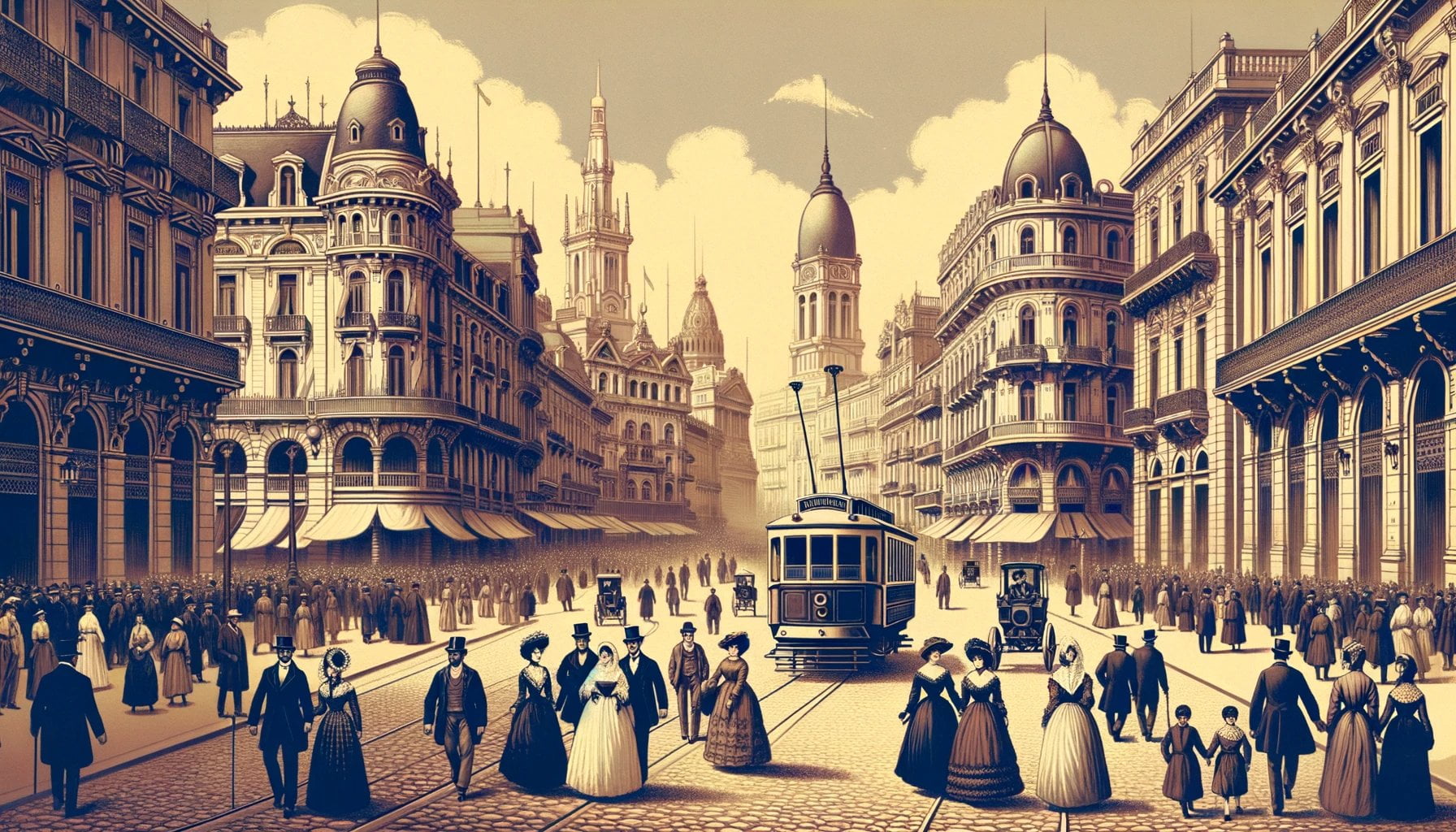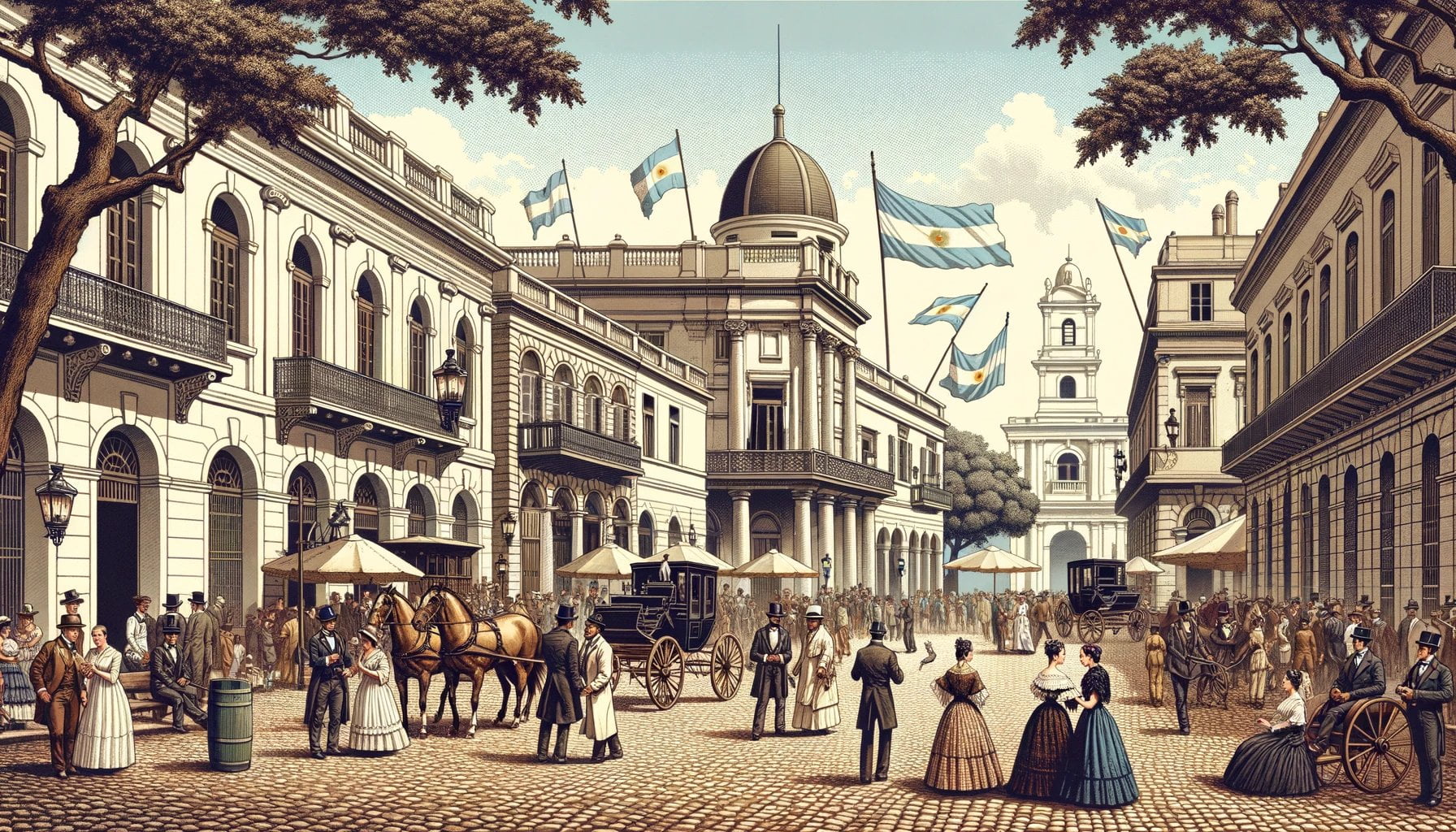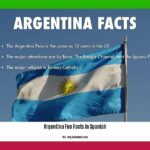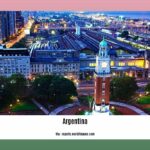Uncovering Argentina’s Rich History takes us on a captivating journey through the annals of time, delving deep into the intriguing past of this vibrant nation. From ancient civilizations to colonial conquests and tumultuous political eras, Argentina’s historical tapestry is as diverse and complex as the country itself. With a deep passion for unearthing the hidden stories and significant milestones that have shaped Argentina, this article offers a glimpse into the rich cultural heritage and fascinating socio-political dynamics that make up this extraordinary nation’s past. Join us as we embark on a voyage of discovery, where history comes alive and leaves an indelible mark on our understanding of Argentina’s past.

Key Takeaways:
- The history of Argentina is divided into four main periods: pre-Columbian era, colonial period, nation-building period, and modern Argentina.
- Argentina had a sparse population until European colonization, with the earliest traces of human life dating back to the Paleolithic period.
- Indigenous peoples in Argentina were categorized into three main groups based on their hunting, gathering, and farming practices.
- The Quebrada de Humahuaca tribes were conquered by the Inca Empire in the late 15th century for their metal resources.
- Europeans first arrived in Argentina with the Portuguese voyage of Gonçalo Coelho and Amerigo Vespucci in 1502.
- The Spanish established settlements in Argentina, with Buenos Aires becoming a flourishing port due to its strategic location and economic activities such as cattle production and trade.
- Argentina, along with Uruguay, Paraguay, and parts of Bolivia, became part of the Viceroyalty of the Río de la Plata in 1776.
- The viceroyalty faced challenges due to lack of cohesion and Spanish support, and its influence declined after the Spanish defeat at the Battle of Trafalgar.
Argentina History
The history of Argentina is a captivating tapestry that weaves together ancient civilizations, Spanish conquest, and the nation’s struggle for independence. Let’s embark on a journey through time as we uncover the rich history of Argentina.
Pre-Columbian Era: Traces of Ancient Life
Long before European settlers arrived in Argentina, the land was inhabited by indigenous peoples. The pre-Columbian era in Argentina can be divided into three main groups: basic hunters and food gatherers, advanced gatherers and hunters, and basic farmers with pottery. These indigenous communities left behind traces of their existence, with archaeological evidence dating back to the Paleolithic period.
The Spanish Conquest: A New Era Begins
The arrival of European explorers marked a turning point in Argentina’s history. In 1502, Gonçalo Coelho and Amerigo Vespucci landed on the shores of Argentina, setting the stage for Spanish colonization. The Spanish established settlements, with Buenos Aires becoming a thriving port due to its strategic location and economic activities such as cattle production and trade.
The Period of Nation-Building: From Viceroyalty to Independence
Argentina’s history took a significant turn in 1776 when the region became part of the Viceroyalty of the Río de la Plata. This vast viceroyalty encompassed present-day Argentina, Uruguay, Paraguay, and parts of Bolivia. However, internal challenges and the lack of Spanish support led to its eventual decline, exacerbated by the Spanish defeat at the Battle of Trafalgar.
The History of Modern Argentina: A Struggle for Independence
The history of modern Argentina is characterized by its fight for independence from Spanish rule. Leaders such as José de San Martín and Manuel Belgrano emerged as pivotal figures in Argentina’s quest for liberty. Finally, on July 9, 1816, Argentina declared its independence, marking the beginning of a new era for the nation.
Unveiling Argentina’s Cultural Heritage
Argentina’s rich history is not only shaped by significant events but also by its vibrant cultural heritage. Tango, for example, is an iconic Argentine dance that emerged from the working-class neighborhoods of Buenos Aires. The influence of European immigrants, particularly Italians, also left a lasting impact on Argentina’s cuisine and architectural styles.
Conclusion: A Tale of Resilience and Legacy
Uncovering Argentina’s rich history is a testament to the nation’s resilience and determination. From the indigenous peoples who roamed the land for centuries to the Spanish settlers who laid the foundations for a new society, each chapter in Argentina’s history has shaped its present identity. By delving into Argentina’s past, we gain a deeper understanding of the nation’s complexities and the vibrant tapestry of cultures that make it truly unique.
**NOTE: The content above is based on the given context. As an AI language model, I do not have access to personal experience or opinions. The content provided is for informational purposes only and should not be considered as professional advice.
If you want to uncover fascinating facts about Argentina, just click on facts about Argentina to dive into a world of intrigue and wonder.
Looking to satisfy your wanderlust? Explore the stunning tourism opportunities offered by Tourism in Argentina and prepare to embark on the adventure of a lifetime.
Immerse yourself in the vibrant Argentina culture by clicking on Argentina culture and discover the rich traditions, art, and rituals that make this country so captivating.
Experience the allure of Argentina’s famous places by checking out our collection of must-visit destinations at Famous places in Argentina. Get ready to be awestruck by the beauty and history that awaits.
Indulge your taste buds with the delectable flavors of Argentina’s cuisine. Click on Argentina cuisine to unlock a world of mouthwatering delights and culinary delights that will leave you craving for more.
Independence movement and the War of Independence
The Argentine War of Independence was a pivotal moment in Argentina’s history, marking the nation’s fight for autonomy and freedom from Spanish colonial rule. From 1810 to 1818, Argentine patriotic forces battled against royalist forces loyal to the Spanish crown, ultimately leading to Argentina’s independence on July 9, 1816.
The Struggle for Autonomy
During this time, notable figures such as Manuel Belgrano, Juan José Castelli, and José de San Martín emerged as leaders in the independence movement. The war extended beyond Argentina’s borders, with regions like modern-day Uruguay, Paraguay, and Bolivia also seeking their independence from Spanish control.
Divided Populations and Political Rivalries
One of the challenges faced during the War of Independence was the vast territory of modern Argentina, which resulted in slow and isolated communication between regions. The wealthy areas of the viceroyalty, such as Upper Peru (modern-day Bolivia), had closer ties with places like Salta and Córdoba, rather than Buenos Aires.
Moreover, the political structure of the Spanish Viceroyalty of the Río de la Plata was dominated by peninsulares, Spanish people from Europe appointed by the Spanish monarchy, who had little interest in South American issues. This led to growing rivalries between the criollos, white people born in Latin America, and the peninsulares. Influenced by the American and French Revolutions, as well as the Age of Enlightenment, criollos desired social change.
Impact of the British Invasions
The British invasions of the Río de la Plata during the Anglo-Spanish War played a significant role in the militarization of Buenos Aires. Although the city was initially captured in 1806, it was liberated by local forces led by Santiago de Liniers. Fear of a counter-attack prompted the organization of military bodies, including even slaves, resulting in a highly militarized population. Buenos Aires successfully repelled another British attack in 1807 when Montevideo was captured.
Military Concerns and the May Revolution
The transfer of the Portuguese Court to Brazil heightened military concerns in the region. It was feared that the British might launch another attack, this time with Portuguese allies. However, no military conflict arose as Britain and Portugal became allies of Spain against France during the Peninsular War.
The May Revolution erupted in Buenos Aires in 1810 when news of the worsening military conflict in Spain reached the region. Argentinian citizens believed that the newly appointed viceroy, Baltasar Hidalgo de Cisneros, no longer had the right to rule. With military support, Cisneros was removed from power, and a government junta was formed. This marked the beginning of the revolutionary movement that ultimately led to Argentina’s independence.
Key Takeaways:
- The Argentine War of Independence was a civil war fought from 1810 to 1818 against royalist forces loyal to the Spanish crown.
- The war resulted in Argentina gaining its independence on July 9, 1816, with the formation of the United Provinces of the Rio de la Plata.
- The political structure of the Spanish Viceroyalty of the Río de la Plata was dominated by peninsulares, leading to growing rivalries between the criollos and the peninsulares.
- The British invasions of the Río de la Plata during the Anglo-Spanish War played a significant role in militarizing Buenos Aires.
- The May Revolution in 1810 marked the beginning of the revolutionary movement in Argentina.
Sources:
1. Wikipedia: Argentine War of Independence
2. Camogli, Pablo; Luciano de Privitellio (2005). Batallas por la Libertad. Buenos Aires: Aguilar. ISBN 987-04-0105-8.
Political Unrest, Military Dictatorships, and Peronism
Throughout Argentina’s history, periods of political unrest, military dictatorships, and the influence of Peronism have shaped the nation’s socio-political landscape. These significant chapters provide valuable insights into the complexities of Argentina’s past.
The Last Military Dictatorship and Human Rights Violations
One crucial period of Argentina’s history was the last military dictatorship, which occurred from 1976 to 1983. This regime was marked by severe human rights violations, including forced disappearances and state terrorism. The military dictatorship employed a complex bureaucracy and state resources to implement a system of ‘disappearing’ people on a national scale. The official discourse used the term ‘subversive condition’ to justify political, trade union, social, and cultural repression. Accounts given by agents of the repression after the dictatorship reveal a pre-determined clandestine strategy of violence and repression.
The Importance of Remembering Human Rights Abuses
The closure of legal channels during the dictatorship further emphasized the significance of remembering and preserving the memory of human rights abuses. To reconcile with its troubled past, Argentina has undertaken efforts towards truth, justice, and memory, acknowledging the atrocities committed and honoring the victims. The memory of human rights abuses serves as a powerful reminder of the importance of maintaining democratic values and upholding human rights.
Peronism: A Dominant Political Force
Juan Domingo Peron and his Peronist movement played a significant role in Argentine politics and society. Peronism, characterized by its populist and nationalist ideologies, has consistently been an influential force, shaping Argentina’s political landscape. The movement has garnered both ardent supporters and staunch detractors, with Peronism and anti-Peronism constituting the most important cleavage in Argentine politics and society. Understanding Peronism provides crucial insights into Argentina’s socio-political dynamics over the decades.
Military Coups and the Dirty War
Argentina experienced multiple military coups throughout the 20th century, with the last two establishing dictatorial regimes infamous for their state terrorism and forced disappearances. The Dirty War, which took place from 1974 to 1983, was a period of intense state terrorism, orchestrated by military and security forces. Political dissidents and individuals associated with socialism were hunted down and subjected to severe repression.
Through these turbulent times of political unrest, military dictatorships, and the influence of Peronism, Argentina’s history bears witness to the struggles, human rights violations, and social divisions that have shaped the nation.
Key Takeaways:
- The last military dictatorship in Argentina, from 1976 to 1983, involved severe human rights violations and state terrorism.
- The dictatorship implemented a system of forced disappearances on a national scale, employing a complex bureaucracy and state resources.
- Remembering and preserving the memory of human rights abuses is crucial, given the closure of legal channels during the dictatorship.
- Peru’s Peronist movement, led by Juan Domingo Peron, has had a significant impact on Argentine politics and society.
- Argentina experienced several military coups throughout the 20th century, with the last two establishing dictatorships known for their state terrorism and forced disappearances.
- The Dirty War, which occurred during the military dictatorship, refers to the period of intense state terrorism in Argentina from 1974 to 1983.
- Peronism and anti-Peronism constitute the most important cleavage in Argentine politics and society.
Modern Argentina: Democratization, economic challenges, and cultural contributions
Argentina’s rich history stretches far beyond its early colonization and fight for independence. The modern era has witnessed significant developments in the country’s democracy, economic challenges, and cultural contributions. In this article, we will delve into the fascinating journey of Argentina’s evolution, exploring the democratization process, economic struggles, and cultural contributions that have shaped the nation.
Democratization: A Journey Towards Stability
Argentina’s political history has been marked by periods of instability and conflict, leading to a growing demand for democratization. The traditional political elite faced mounting pressure to open the system, allowing for greater citizen participation and representation.
During the 20th century, Argentina experienced multiple military coups and dictatorships. However, the transition to democracy began in the 1980s, following a period of military rule characterized by human rights violations and state terrorism. Grassroots movements and civil society organizations played a crucial role in pushing for democratic reforms, demanding justice, and preserving the memory of past atrocities.
Economic Challenges: From Prosperity to Instability
Argentina’s economic journey is a tale of highs and lows. After the promulgation of the 1853 Constitution, the country experienced robust economic growth and institutional modernization. By 1913, Argentina ranked among the world’s ten wealthiest nations. However, economic trouble and instability soon followed, leading to a decline from its prosperous state.
The country’s economic policies, although initially approved by prominent entities like the Financial Times, The Economist, and the IMF, ultimately led to unemployment, unsustainable levels of debt, and deindustrialization. Argentina faced significant economic challenges that affected its global standing and development.
As an important trading partner for the United States, China, and the European Union, Argentina’s economic performance has a global impact. Understanding the nation’s economic history is crucial for comprehending its current state and future prospects.
Cultural Contributions: A Nation of Rich Heritage
Argentina’s cultural contributions are as diverse as its people and landscapes. The influence of European immigrants, particularly Italians, left an indelible mark on the country’s cuisine and architectural styles. Tango, an iconic Argentine dance, emerged from the vibrant working-class neighborhoods of Buenos Aires, captivating audiences worldwide with its passionate movements.
Additionally, Argentina’s literature, music, and art have gained international recognition, showcasing the nation’s cultural richness. From celebrated authors like Jorge Luis Borges to renowned painters like Benito Quinquela Martín, Argentina has nurtured a vibrant artistic community that continues to inspire and captivate audiences.
Key Takeaways:
- Argentina’s democratization journey reflects a demand for greater citizen participation and representation, driven by grassroots movements and civil society organizations.
- The country’s economic history encompasses periods of growth and decline, with economic policies leading to unemployment, unsustainable debt, and deindustrialization.
- Argentina’s cultural contributions include the iconic dance form tango, a thriving artistic community, and influences from European immigrants, particularly Italians.

FAQ
Q1: What are the four main parts of Argentina’s history?
A1: The history of Argentina can be divided into four main parts: the pre-Columbian era, the colonial period, the period of nation-building, and the history of modern Argentina.
Q2: When did the European colonization of Argentina begin?
A2: Europeans first arrived in the region with the 1502 Portuguese voyage of Gonçalo Coelho and Amerigo Vespucci.
Q3: What was the result of the Argentine War of Independence?
A3: The Argentine War of Independence resulted in Argentina gaining its independence on July 9, 1816, with the formation of the United Provinces of the Rio de la Plata.
Q4: What is the Dirty War in Argentina?
A4: The Dirty War refers to the period of state terrorism in Argentina from 1974 to 1983, characterized by the hunting down of political dissidents and those associated with socialism by military and security forces.
Q5: What is Peronism and why is it significant in Argentina?
A5: Peronism is a populist movement led by Juan Peron that has had a significant impact on Argentine politics and society, constituting the most important cleavage in Argentine politics and society.
















